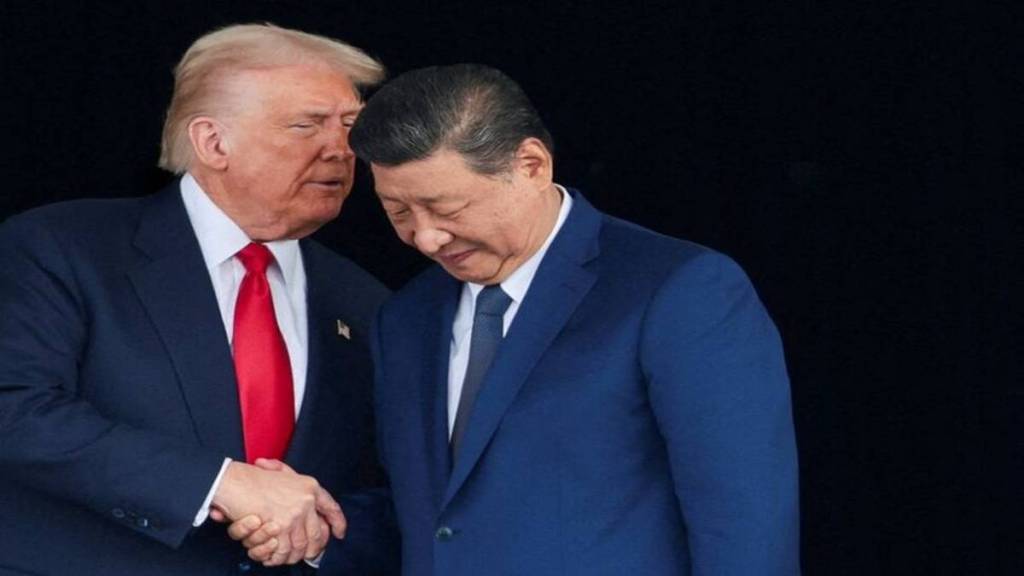By Harsh V Pant & Vivek Mishra, Respectively Vice-President, Studies and Foreign Policy, and Fellow, Americas, ORF
In any era, one of the most noticeable ways in which the direction of shifts in the global order can be identified is to monitor the great powers’ behaviour. Clearly, the spectrum of developments that lies between China’s rapid ascent in the past two decades and the US’s recalibration since have been the single most important trend outlining the character of the impending order. In this context, the recent meeting between Donald Trump and Xi Jinping has been a timely reflection. Coming after six years, the meeting between Trump and Xi in Busan was perhaps the intended pinnacle of Trump’s three-nation Asia trip. It combined Trump’s desire to project an America-on-the-top image vis-à-vis China with the urgency to bring down tensions in the US.
The Trump-Xi meeting is at best a mixed-bag assessment, much being also contingent on the next steps in both implementing the tenets of agreement and the appetite for future risk reduction. For China, going into the bilateral meeting on the back of punitive tariffs on rare earths that it imposed on the US was an audacious display of its leverage in critical sectors. Besides, China used its halt of soya bean import from the US as an effective leverage. In principle, these led to the US dropping import tariffs by 10% on Chinese goods, suspending port fees on Chinese ships, and delaying US export controls that would have choked access to technology for China, particularly since the Biden presidency. The growing chorus around which either country ceded more grounds than it gained underscores the tenuous nature of the year-long truce that has been achieved in the latest round.
Various factors underscore the unease around the US-China truce, both among the two parties as well as the stakeholders who sit on the outside of this emerging paradigm. For the US and China, the current understanding may at best be temporary, given the structural nature of the bilateral dynamic which remains baked into competitive confrontation. One of the biggest bets against a stable US-China relationship, at least under the Trump administration, is the uncertainty associated with his administration, which makes the possibility for all progress to backslide with another social media outburst. Then there is a broader understanding of a policy slide against China from the Trump administration, which could give China a clear upper hand. This is more evident in the Trump administration’s policies in the tech sector. For a President who, in his first term, took the trade war to China, followed that with a slew of relaxations in tech policy, and fiddled with the idea of granting their most advanced chips to Beijing while lowering its guard on possible transshipments from third countries, Trump seems to be stacking up policy reversals on China, which may blunt the US’s competitive edge. In an age where an artificial intelligence bet may be the most potent weapon to reposition the US ahead of the curve, these steps may prove regressive.
Trump announced his meeting with China as the “G2”—a strategic dyad smacked of a strategic compromise. However, it was totally one-sided, as China did not reciprocate on the notion of any such geopolitical composition—if anything, China has harped on a multipolar idea of Asia and the world, at least in principle. It thus retracts Washington’s grand strategy designs abroad, particularly in Asia. Such assertions will have to be accompanied by policies which carve out more strategic space for China, particularly in the Indo-Pacific, eroding the US capability and trust.
The US and China are at the top of the global economic order pyramid and naturally compel knock-on impacts for virtually the whole world, but indeed more consequentially for economies that rank close to the top of that pyramid. India, by that measure, is at a crossroads. India’s economic dependence on both the US and China places it at a unique juncture, especially in that neither seems favourable. Trump’s continuous tariffs on India make the trade surplus with the US a liability and China remains advantageous through a trade surplus over India. While diversifying its trade dependence basket over a wide range of geographies and sectors in the next few years remains New Delhi’s horizon view, the lack of any knee-jerk reactions may be a steady policy alternative. The great power turbulence, however, also provides India with the opportunity to build upon its own commitments in the Indo-Pacific region while the US recentres focus on the western hemisphere and on domestic issues. Such policy orientation is likely to intensify from Washington even as the mid-term elections come closer. More specifically, it may be the perfect opportunity to restrengthen the bilateral and the trilaterals, which form the base of multilateral formations like the Quad.


